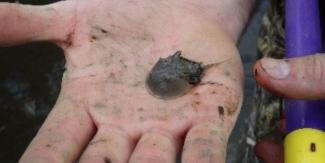Horseshoe Crab Spawning Survey
Background
Every year, horseshoe crabs (Limulus polyphemus) make their way to the shores of Rhode Island to engage in a lunar and tidal driven spawning event. Female horseshoe crabs crawl onto the beach during the new and full moons during late spring and early summer to lay eggs in a concentrated nest. Male horseshoe crabs follow shortly behind them to fertilize up to 4,000 eggs per nest. In less than a month, the juvenile horseshoe crabs emerge and make their way back to the water.
Survey Design and Methods
Two stretches of beach are currently involved in this monitoring survey. The northern site, located in Conimicut, is a residential shorefront measuring approximately .3 miles. The southern site, located in the Napatree Point Conservation Area, is a protected shorefront measuring approximately 1.25 miles. During the new and full moons of May, staff scientists visit each site at the evening high tide to count how many horseshoe crabs are visible in shallow water and on shore. These counts include individuals as well as mating groups.
Sampling Frequency
Locations are sampled annually on the new and full moons during the month of May.
For more information about the survey please contact Katherine.Rodrigue@dem.ri.gov.


